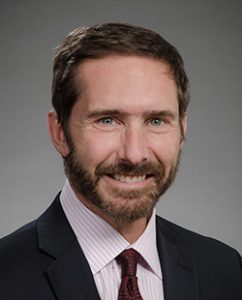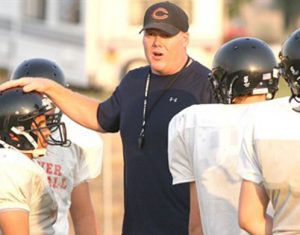Big Lungs, Huge Heart
UW Medicine | ACCELERATE | April 24, 2019
Brought together by a double-lung transplant, a patient and his surgeon reflect on their connection.

Michael Mulligan, MD Professor & Chief, Division of Cardiothroacic Surgery Section Chief, Thoracic Surgery
Anyone who’s talked to Coach Shea Little feels compelled to tell you how warm, generous and caring he is. And that kindness is one reason Little means so much to his students and his community — and to his transplant surgeon, Michael Mulligan, M.D.
Today, Little — who, at 6’7”, doesn’t quite fit his name — coaches football and baseball. But, like many coaches, he loved to play. He was good, too.
In high school, Little earned a full-ride athletic scholarship to Portland State University; after transferring to Eastern Oregon University, he was picked up by the St. Louis Rams in 1997. But when a foot injury continued to bother him during the season — and, later, while playing with NFL Europe’s Scottish Claymores — Little made the tough decision to quit professional sports.
 His family settled in Bend, Oregon, where Little became athletic director at Culver High. “I wanted to help youngsters have a great high-school experience,” he says. And while the problem with his foot dwindled in significance, another chronic condition was moving to the fore.
His family settled in Bend, Oregon, where Little became athletic director at Culver High. “I wanted to help youngsters have a great high-school experience,” he says. And while the problem with his foot dwindled in significance, another chronic condition was moving to the fore.
For years, Little had suffered from breathing problems. Originally diagnosed with exercise-induced asthma, he figured he just needed to work harder and build up more strength. But even after leaving professional football, his lungs grew progressively weaker. In 2011, genetic testing finally yielded an answer: Little had an obscure genetic disorder known as alpha-1 antitrypsin (AAT) deficiency that affects the liver and the lungs.
By 2016, Little’s lung function had deteriorated to 30 percent. That’s when his doctors knew it was time to put him on a lung transplant list at UW Medicine. Because of his size and the disease process that had further enlarged his lungs, however, the donor lungs would need to be extra-large — and donors with extra-large lungs are very rare.
Waiting for a new set of lungs meant preparing for life to change at any moment. Little continued to coach, but he couldn’t drive the team to away games, in case he got the call and had to fly to UW Medical Center for surgery. Coaching outdoors in bad weather wasn’t recommended, either, but Little refused to stop doing what he loved, even when he struggled to walk from the dugout to the third-base line.
In May 2018, the call came; Mulligan, chief of the Division of Cardiothoracic Surgery, would be Little’s surgeon. Mulligan saw something of himself in his patient: He also had an athletic career cut short by health problems. And their shared faith was a source of strength and connection for both.
“When you sense kindred spirits, your personal understanding of their experiences is deepened considerably,” says Mulligan.
After a successful surgery, Little stayed in transplant housing for three months before returning home. Although he’s not teaching, due to the germ-rich classroom environment, he’s still coaching and training students.
“I like teaching them life lessons and motivating them to work hard, strive for their goals and reach for the opportunities that can improve their lives,” Little says.
So far, none of Little’s four children — three of whom are also college athletes, the fourth in high-school sports — has shown signs of having the disease, which typically appears in a person’s late twenties or early thirties. For now, the family is taking it day by day, and Little is hopeful.
“I appreciate the time that UW Medicine has given me with my family,” Little says. “I want to see my kids grow up and meet my grandkids one day.”
Little still returns to Seattle for follow-up care, and when he does, he visits with Mulligan. They inspire each other.
“Whenever I talk to Shea, I always try a bit harder to raise the bar for myself, because he gives so much back,” says Mulligan. “He is a powerful force for good on this earth.”
ACCELERATE PATIENT CARE
With a gift to the Lung Transplant Program Fund >>
